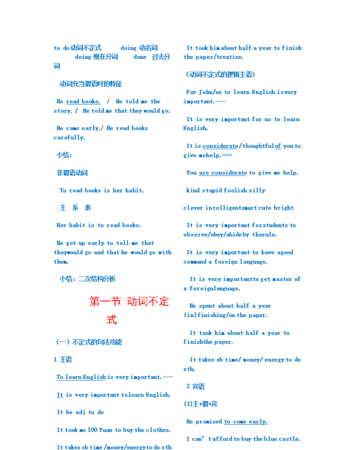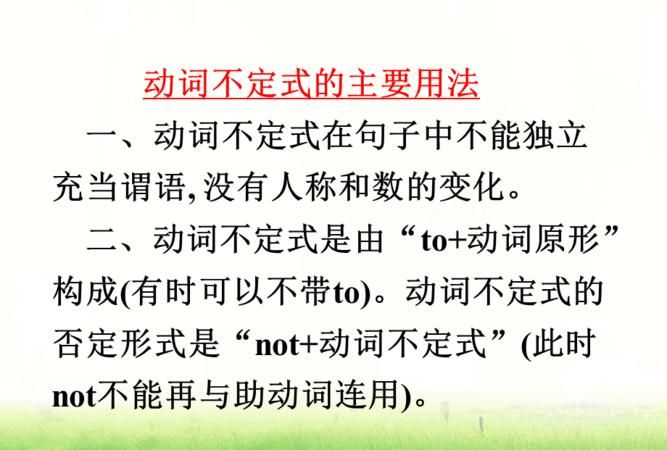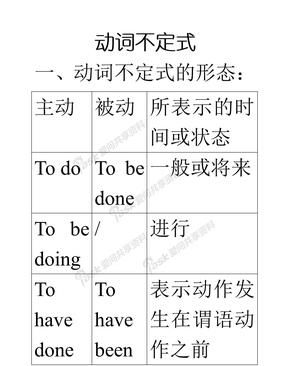本文目录
八年级英语上册单词跟读
1, 构成:to 加原形动词。否定形式:not to do

八年级下册动词不定式的用法总结
动词不定式的基本形式为to+动词原形。
1. 动词不定式做主语。谓语用第三人称单数形式。如果主语较长则用it做形式主语,将真正的主语动词不定式放到句尾。eg
To see is to believe.
It's a bad habit to run after dinner.
2 做表语。the important things is to save lives.
3 做宾语he likes to play with children.
4做宾语补足语. 形容词做宾补时。常用it做形式宾语。 把真正的宾语放到宾补之后。
he feels it happy to help others.
5做定语she asked me to help her with her English.
6做状语you are never too old to learn.(结果状语)
7特殊疑问词+动词不定式。I am thinking about what to say.

动词不定式
动词不定式的用法
在初中时,我们就学过动词不定式,现就其用法归纳如下。
动词不定式在句中可充当主语、表语、宾语、宾补、定语和状语等。
一、作主语
动词不定式作主语可位于句首。例如:
To learn a skill is very important for everyone in society.
也可使用it作形式主语,而将其置于句末。例如:
It is necessary for young students to learn a foreign language.
动词不定式作主语的常用句型有:
1. It is+adj./ n. (+for sb./sth.) + to do sth.
用于此句型的形容词有:easy, hard, difficult, possible, important, impossible, necessary, good, bad, exciting, interesting, surprising等。例如:
It is interesting to play this game.
It is necessary for you to change your job.
It was impossible for them to complete the task in such a short time.
考例1:Is ____ possible to fly to the moon in a spaceship? (88 MET)
A. now B. man C. that D. it
用于此句型的名词有:pity, shame, pleasure, one’s duty, one’s job, fun, joy, good manners, bad manners等。例如:
What a pity it is for you to have missed such a wonderful film.
It is good manners for the young to give their seats to the old.
2. It is+adj.+of sb.+to do sth.
该句型中只能使用描述某人的品德、特征的形容词,如: kind, nice, wise, silly, polite, impolite, friendly, foolish, clever等。例如:
How rude it was of the boy to jump the queue!
It is friendly of the family to try to make me feel at home in their house.
How silly it was of you to give up such a good chance!
3. It takes sb.+some time+to do sth.
该句型意为“做某事花费某人多长时间”。例如:
It took us half an hour to ride to the town by bike.
二、作表语
动词不定式作表语常用于以下结构:My wish/ job/ aim/ goal is…及The next step/ measure is …等。例如:
Your job is to type the papers in the office.
The next measure is to stop the river from being polluted.
三、作宾语
常见的只能使用动词不定式作宾语的动词有:agree, choose, decide, hope, fail, wish, refuse, expect, manage, plan, intend, pretend, promise, offer, afford, demand, arrange等。 例如:They decided to build a highway between these two cities.
She offered to help me when I was in trouble.
believe, think, consider, feel, make等动词可用于“动词+ it +adj. / n+to do sth.”句型,其中使用it作形式宾语,而将真正的宾语动词不定式置于句末。例如:
I think it necessary for us to have a good rest after the long work.
She felt it her duty to help the old woman.
四、作宾补
可后接动词不定式作宾补的动词有:advise, allow, ask, hear, order, see, tell, want, wish, watch等。例如:
The doctor advised her no to eat too much sugar.
I wish you to go to the meeting with me.
believe, consider, count, declare, deny, feel, find, guess, imagine, judge, know, prove, realize, suppose, think等动词后可接to be型不定式作宾补。例如:
He declared himself to be a college student. 他自称是名大学生。
The police proved him to be a thief. 警察局证实他是小偷。
hope, demand, suggest等动词不能后接动词不定式作宾补。例如:
【误】I hope my son to be back soon.
【正】I hope my son will be back soon.
【误】She suggests us to have a discussion about it.
【正】She advises us to have a discussion about it.
【正】She suggests that we (should) have a discussion about it.
在主动结构中,下列动词后作宾补的动词不定式应省略to:“五看”(see, watch, notice, observe, look at)“三使”(make, let, have)“两听”(hear, listen to)“一感觉”(feel)。例如:
Who made him work all night long?
但是,改为被动结构后,应补出省略的to。例如:
He was seen to break the window.
五、作定语
动词不定式作定语,应位于所修饰词语之后,即:作后置定语。例如:
Have you got anything to eat? (to eat修饰anything,位于其后)
下列名词后常接动词不定式作定语:ability, attempt, chance, courage, decision, effort, failure, promise, way, wish等。例如:
But she gave up the chance to go abroad.
由only, first, last, next以及序数词或形容词最高级修饰的名词后,也常接不定式作定语。例如:
Who was the last one to leave the classroom last night?
六、作状语
动词不定式作状语,可表示目的、原因、结果或条件。例如:
We went there to see our grandparents.(目的)
I am very sorry to hear that.(原因)
She hurried home only to find her father dead.(结果)
To look at the picture, you would like it.(条件)
作目的状语,还可以使用in order to或so as to。例如:
The boy worked so hard in order to make up for the lost time.
结果状语还可以使用enough to, too…to…, so…as to, such… as to等结构。例如:
He got up too late to miss the early bus.
She was in such a hurry as not to notice me. 她如此匆忙,以致没有注意到我。
hope it can help you!

初二动词不定式归纳
1.作主语 作主语用的动词不定式常常用it替代,动词不定式(或短语)放在后面。例如: It's easy to get lost in a big city like Tokyo.在东京这样的大城市容易迷路。 It is terrible to see the ship sinking into the sea.目睹轮船沉入大海,真是太可怕了。 2.作宾语 Indians like to eat hot food.印度人喜欢吃辣味食品。 They need to look at a map.他们需要查看地图。 有的动词不定式在作带有补足语的宾语时,前面往往带有形式宾语it。例如: Do you think it necessary for us to learn to wait?你认为学会等待对我们来说很必要吗? They improved the software to make it easier for people to use computers.他们改进了软件,使人们使用计算机更简便了。 3.作表语 It seems to be an interesting book.它看起来是本有趣的书。 The old man's job is to take care of the flowers in the garden.这位老人的工作是照料花园里的花。 4.作宾语补足语 He told me not to bring you anything.他叫我不要给你带任何东西。 Who taught you to play the music?谁教你弹这支曲子的? 5.作定语 动词不定式作定语时,要放在它所修饰的名词或代词后面。例如: In my dreams I always have very difficult jobs to do.我在梦里总是做一些艰难的工作。 Every day he made one of the smaller animals bring him something to eat.他每天叫一个小动物给他带来吃的东西。 6.作状语 (1)表示目的 You can hide under my seat when the conductor comes to check the tickets.当列车员来查票时,你可以藏在我的座位下面。 In his third year,he left Harvard to work for a company called Microsoft.在三年级时,他为了去微软公司工作而离开了哈佛大学。 (2)表示结果 动词不定式作状语表示结果时常与副词too或enough连用。例如: It's too heavy to carry.太重了搬不动。 The Californian ship arrived too late to save more people.加利福尼亚号来得太晚,没能挽救更多的人。 7.和某些形容词连用 和动词不定式经常连用的形容词有sure,ready,happy,sorry,afraid等。例如: He's very happy to see his wife.他见到妻子非常高兴。 I'm sorry to trouble you.很抱歉打扰你了。 8.和疑问词who,what,when,where,which,how构成不定式短语作宾语。例如: I don't know how to use a computer.我不知道怎样使用计算机。 Can you tell me when to start?你能告诉我什么时候出发吗?

以上就是关于初二动词不定式归纳 ,八年级英语上册单词跟读的全部内容,以及初二动词不定式归纳 的相关内容,希望能够帮到您。
